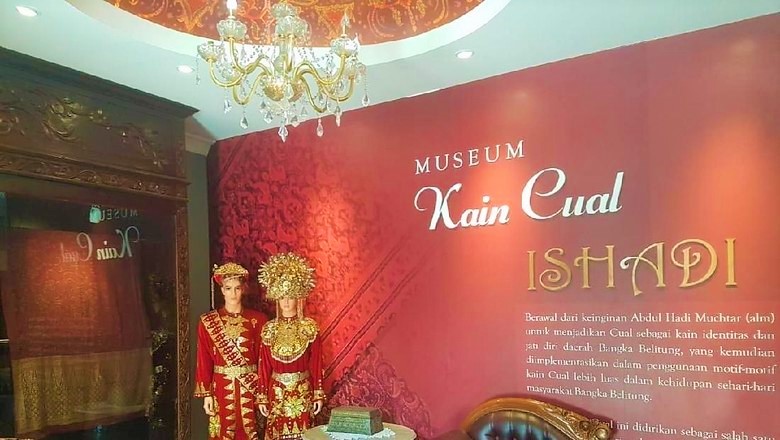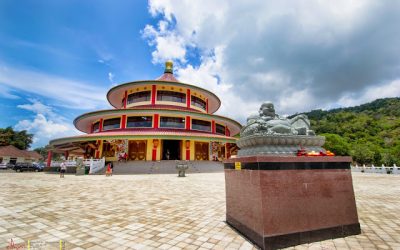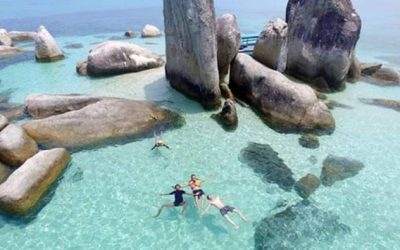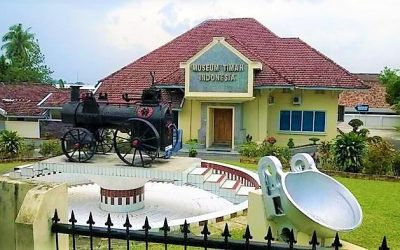Home / Batik Regions – Western Indonesia – Southern Sumatra – Bangka Belitung / Cual Woven Textile Museum
Cultural Destination
Embrace the spirit of the place!
Cual Woven Textile Museum
This museum is the first and only museum in Pangkalpinang that provides insight into the typical woven fabric of Bangka Belitung. Ishadi Cual Fabric Museum displayed a 200-years-old woven fabric and other precious textile heritage. Cual weaving was originally a traditional cloth from the Muntok region, developed around the 17th century. Cual woven cloth is very famous for its smooth texture. Its variety of flora and fauna patterns stand out like a relief of motifs when viewed from a distance.
Tourist Attractions in Bangka Belitung
Tri Agung Buddhist Shrine in Tikus island
Enjoying the beauty of the beach and discovering spiritual tourism, why not?
Tanjung Kelayang Geopark
Could you imagine if a Stonehenge was ever built on the beach?
Tin Museum
Bangka Belitung Province has the only tin museum ever built today
Bangka Belitung
Batik Motifs
Daun Lada Hitam
The black pepper motif represents the main commodity of Bangka Belitung
Kain Cual
Cual textile tradition has existed since the 17th century. The word “Cual” refers to
Daun Simpor
This motif is inspired by the Simpor plant (Dillenia Suffruticosa) which is a typical
Biji Kopi
The coffee seeds motif illustrates the pride of local coffee specialities in
Discover
Indonesian
Batik
Motifs
Kawung
The Kawung motif was created by Sultan Agung Hanyokrokusumo (1593 – 1645) as a symbolic gift for
Taiganja
Taiganja is a precious gold pendant that shows the social status of the Kaili family. It is
Kaganga Tanah Rejang
If Batik Besurek combines Arabic calligraphy motifs, then the Kaganga batik takes
Gamolan
This motif illustrates Gamolan, a bamboo musical instrument of Lampung that is
Kaharingan
The Kaharingan or ‘tree of life’ based on the Dayak tribes’ belief system. This tree symbolizes
Tampuk Manggis Sasirangan
The motif illustrates the philosophy of the mangosteen fruit, which is
Salakanagara
Salakanagara batik motif illustrates the first kingdom in the Betawi land
Parang Seling
Parang Seling or “alternating daggers” is a royal batik motif. It is a feminine variant of
Daun Lada Hitam
The black pepper motif represents the main commodity of Bangka Belitung
Gumin Tambun
Based on Hindu mythology, this motif symbolizes lucks, abundant wealth, and
Angsa Duo
According to legend, the Angso duo batik motif is a pair of swans that are believed to have led Princess
Prada Papua
The word “Prada” in the Javanese-Indonesian dialect means a batik textile that
Kuda Kupang
Horses symbolize wealth. It contains noble values of virtuous characters that bring
Tongkonan
Toraja’s traditional house is called Tongkonan. Tongkonan is a place for
Dayak Taghol
Dayak Taghol has a distinctive style of four curved lines and small dots. This motif represents
Malinau Cultural Festival
You will witness a unique competition that might not be found other than in
Jumputan Bintang
The word Jumputan means the tie-dye technique, while the word “Bintang” refers to
Kasih Tak Sampai
‘Kasih Tak Sampai’ is an idiom in the Indonesian language which refers to
Pati-Pati Pinehiku
It symbolizes the hierarchy in society and the social status of the Mekongga
Sandeq
Sandeq Boat is a symbol of the maritime importance of the West Sulawesi region. The greatness of
Sekar Jati
Sekar means flower and Jati refers to teak trees that symbolizes a strong mental character that
Jupri Kembang Teh
Kembang Teh illustrates the tendrils of tea plants that grow in the highlands of
Tubo Kelapa
Coconut tree is a symbol of a good character and strong mentality. It illustrates the more success a person, the more
Singayaksa
The Singayaksa motif comes from the name of a place where Sultan Hasanuddin used to
Parang Rusak
Another meaning behind this motif is an unconquerable spirit, symbolized by
Desa Na Tolu
The Desa Na Tolu characteristic pattern symbolizes the Batak philosophy of existence and
Ikan tambal
The word “Ikan” refers to fish. The philosophical meaning of Ikan Tambal means is
Gonggong Siput
Gonggong (Strombus Turturella) is one type of sea snail found around
Sekomandi
Its philosophical meaning is the eternal union which refers to a saying “until death do us part”
Buketan Bali
The Balinese bouquet (Buketan Bali) is a floral arrangement and the name is
Wirasat
Wirasat or divine inspiration is a gift from God. This inspiration is symbolized by
Gurdo Solo
Gurdo or garuda bird is the mount of the Indian god Vishnu. As the Sun Bird,
Kerawang Tegak Aceh
The Vertical Upright (Kerawang Tegak) Motif symbolizes a person who has a strong
Merak Ngeram
The hatching peacock motif has a very deep meaning which refers to the sacrifice and
Tangerang Herang
Tangerang Herang motif is a symbol of Tangerang city. The Tangerang Herang batik motif consists of
Sero Tangga
The Sero Tangga illustrates an endearing feeling and sacrifices of a person to fulfil
Tabir Tanjung
Tanjung flower is a type of Cherry tree flower, which is commonly found in
Insang Ikan
Insang refers to the gills of the fish. This is a typical pattern of Malay ethnic who inhabits
Teguh Bersatu
This batik motif shows the strength of the people of Kupang. It also represents a sense of
Raja Ampat
Raja Ampat motif represents the marine life at Raja Ampat archipelago in
Besurek Rafflesia
The term “Basurek” refers to a textile that contains letters or inscriptions
Dayak Kamang
Kamang motif is generally found in the Dayak tribe shield because it is believed to
Daun Sirih
This motif illustrates betel leaves that are used by Lombok communities as traditional
Tanah Liek
The word “Tanah Liek” refers to clay in Minang language. It is also known as
Leuit Sijimat
This motif reflects the daily activities of the Baduy tribe in Banten. The main ornaments of batik motif consist of:
Burung Bidadari
Bidadari birds are endemic birds in Halmahera. This motif represents an
Daun Simpor
This motif is inspired by the Simpor plant (Dillenia Suffruticosa) which is a typical
Honai
The Honai is inspired by the traditional house of the Papuan community living in
Lontara
The Lontara script itself is a typical ancient script of Bugis and Makassar communities. History records that
Pattimura
Pattimura is the name of an Indonesian hero who fought against colonialism in
Tifa Totobuang
The batik motifs illustrate Maluku’s traditional music instrument called
Awan Berarak
Awan Berarak is a combination of Dayak motifs and Malay patterns. The word ‘Awan Berarak’ means the
Karawo Mahkuta
Mahkuta refers to Gorontalo’s traditional crown. It represents noble characters of
Mahkota Siger
Siger is the crown of a noblewoman in ancient time. It is a symbol of femininity, strength, and
Bale Lumbu
This motif signifies the welfare of the ancient Sasak society. Bale also symbolizes the
Tenun Bima
The motifs are adopted from Bima woven textile. This pattern has received a great
Gigi Haruan Lidi
The Gigi Haruan Lidi motif is taken from the name of the cork fish and is a symbol of
Bomba Mawar
This motif means sacred love for family, kingdom, and God; It also illustrates
Lok Baintan Floating Market
As you can imagine, the most authentic thing is that you can buy things and even
Biji Kopi
The coffee seeds motif illustrates the pride of local coffee specialities in
Rumah Mamuju
the Batik motif illustrates the house of Mamuju King with the stairs, located on the left of the wooden stage house
Kain Cual
Cual textile tradition has existed since the 17th century. The word “Cual” refers to
Durian Pecah
Broken Durian motifs depict the foundation of faith. The second half signifies the mastery of
Rangkiang
The word “Rangkiang” refers to the rice granary in the Minangkabau language. It symbolizes
Paqbarre Allo
The word “Barre” means round and “Allo” means the sunlight. This motif is interpreted as
Keluak Daun Pakis
The word “Keluak” is a Minang language which means twisted or tangled. The Motif of
Tikar Natuna
The Tikar Natuna motif is adapted from the traditional making of pandanus mats in
Lipaq Sabe
Lipaq Saqbe contains a simple geometric classical motif with various flower decorations. This textile is
Ake Patra
Ake is related to the divinity and the composition of the universe. It is a symbol of
Enggang Dayak
Local people beliefs that hornbills are an incarnation of the Commander of the Birds. It has supernatural
Gonggong Beruntun
This motif illustrates that a person should maintain a positive attitude and
Pala Salawaku
This motif illustrates the unique weapons of the Maluku region, namely
Gedhog Kembang Waluh
a combination of Javanese cultural motif of the Majapahit kingdom (XII-XIV century) with




